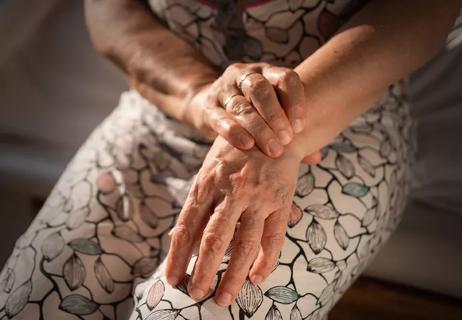From heating pads and ice to exercises and splints, find the relief that works for you

When arthritis takes hold in your thumb, actions you may have taken for granted can become more challenging. Opening jars, turning door knobs or carrying a dinner plate can become monumental — and sometimes painful — feats.
Advertisement
Cleveland Clinic is a non-profit academic medical center. Advertising on our site helps support our mission. We do not endorse non-Cleveland Clinic products or services. Policy
Osteoarthritis of the hand is the second most common type of arthritis in the United States, second only to arthritis in the knee.
Osteoarthritis is commonly seen in the thumb joint where your thumb meets your wrist — also known as your carpometacarpal (CMC) or basal joint. Your CMC joint is responsible for things you commonly use your hand for without even realizing it — the swiveling, pivoting and pinching when you grip items in your hand.
There are a lot of myths about arthritis, so we talked with orthopaedic surgeon David Shapiro, MD, and occupational therapist Patty Shimko, OTR/L, about the signs of arthritis in the thumb and how you can find relief.
The symptoms of thumb arthritis can limit your hand function and make everyday tasks difficult.
“When osteoarthritis causes the cartilage to wear away, the shock- and impact-absorbing function of the cartilage is lost,” Dr. Shapiro says. “The bones can rub against each other, causing stiffness and pain.”
If you’re living with arthritis in your thumb, you may have:
Advertisement
Osteoarthritis is commonly seen in people over the age of 50. Rheumatoid arthritistypically first appears between the ages of 35 and 50.
Anyone can develop arthritis in the hand, but it affects women and people assigned female at birth (AFAB) five times more frequently than men and people assigned male at birth (AMAB), Dr. Shapiro says.
“Women and people AFAB seem to have more joint laxity (looser joints), which leads to malalignment of the joint, cartilage wear, arthritis and pain,” Dr. Shapiro notes.
If you’ve had fractures to your hand or thumb or a history of other injuries in the area, you may also be at a higher risk for developing arthritis. Contrary to popular folklore, cracking your knuckles — while cringe-worthy — doesn’t put you at risk for arthritis.
If you suspect arthritis may be the cause of your thumb pain, talk with a healthcare provider. X-rays can show if you have a loss of bone cartilage and the formation of bone spurs that indicate arthritis. Your healthcare provider may also do a blood test to determine if the cause is rheumatoid arthritis.
There are a few treatments you can try at home to relieve pain in your thumb from arthritis. Dr. Shapiro suggests:
Splints can also provide some pain relief, Dr. Shapiro says. Try a soft splint, similar to a biking glove with a strap that stabilizes your thumb. Hard plastic splints, either custom-made or off the shelf, might also help increase your function and relieve some pain.
Shimko also suggests these practical ways to take some of the burden off your hands:
Exercising your thumb and hands can bring some relief from arthritis pain and help you maintain motion and strength in your hands. Shimko offers these four exercises that can help relieve pain from thumb arthritis:
Advertisement
The U.S. Food and Drug Administration (FDA) doesn’t review or approve supplements. Supplements aren’t required to undergo the same rigorous clinical trial methods that medications must pass. But some clinical trials show glucosamine or chondroitin can improve pain for some people, but there isn’t any proof that these supplements slow the progression of osteoarthritis. Talk with a healthcare provider before using supplements. They may interfere with medications you currently take.
However, some foods like green tea, fish rich in omega-3 fatty acids, nuts and whole grains could help relieve your pain.
If home treatments aren’t doing the trick, it may be time to talk with a doctor about your arthritis pain. Your doctor may recommend some additional medical interventions.
Steroid (cortisone) injections may help. While individual physicians will manage this differently, one or two injections are usually worth a try and may provide lasting relief, Dr. Shapiro says.
If nonsurgical treatment is no longer effective and your pain is overwhelming, surgery might be an option.
Ligament reconstruction and tendon interposition (LRTI) surgery is the gold standard for surgical treatment of basal joint arthritis, Dr. Shapiro says.
Advertisement
LRTI involves the removal of your trapezium (a bone in your wrist located just below your thumb). A “spare” tendon from your forearm is then used to stabilize your thumb. The procedure is performed on an outpatient basis. People usually wear a splint or cast for up to six weeks, typically followed by a course of occupational therapy.
“LRTI provides 95% pain relief and about 70% to 80% return of grip strength,” Dr. Shapiro states. “While complete recovery can take a while, most patients end up much more functional, and much happier after the operation than before.”
Arthritis can be a real pain in the … thumb. While common, arthritis pain in your thumb can make everyday tasks more difficult. Talk to your healthcare provider about ways to make your daily tasks easier and your options for relief.
Advertisement
Learn more about our editorial process.
Advertisement

Simple exercises like tendon glides and finger lifts can have a big impact

Research is inconclusive, so don’t stop eating tomatoes, potatoes and peppers just yet

What’s the difference between these types of inflammatory arthritis?

The link between joint pain and skin rashes

What’s the difference between these types of arthritis?

Remember to start slow and if things don't improve, ask your doctor about more advanced solutions

Working out is one of the best things you can do to improve your symptoms

Use tools, tips and common sense

Type 2 diabetes isn’t inevitable with these dietary changes

Applying a hot or cold compress can help with pain